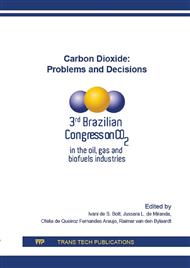[1]
P. Mekala, J.S. Sangwai, Prediction of phase equilibrium of clathrate hydrates of multicomponent natural gases containing CO2 and H2S, J. of Petrol. Sci. and Engineering, v. 116, p.81–89, (2014).
DOI: 10.1016/j.petrol.2014.02.018
Google Scholar
[2]
H. Lee, Y. Seo, S.P. Kang, S. Lee, Experimental measurements of hydrate phase equilibria for carbon dioxide in the presence of THF, propylene oxide, and 1, 4- dioxane, J. Chem. Eng. Data, v. 53 (12), p.2833–2837, (2008).
DOI: 10.1021/je800566y
Google Scholar
[3]
F. Q. Li, J. Y. Liu, X. F. Zhang, J. X. Ren, J. Wu, The Effects of Operation Parameters on CO2 Removal Efficiency by Membrane Method, Advanced Materials Research, Vols 955-959, pp.2326-2329, (2014).
DOI: 10.4028/www.scientific.net/amr.955-959.2326
Google Scholar
[4]
E. T, Rufford, S. Smart, G.C.Y. Watson, B.F. Graham, J. Boxall, J.C.D. Costa, E. F. Maya, The removal of CO2 and N2 from natural gas: A review of conventional and emerging process technologies. J. of Petrol. Sci. and Engineering, v. 94-95, p.123–154, (2012).
DOI: 10.1016/j.petrol.2012.06.016
Google Scholar
[5]
G.C.Y. Watson, N. K Jensen, T. E Rufford, K.I. Chan, E.F. May, Volumetric adsorption measurements of N2, CO2, CH4, and a CO2 + CH4 mixture on a natural chabazite from 5 to 3000kPa. J. Chem. Eng. Data., v. 57(1), p.93–101, (2012).
DOI: 10.1021/je200812y
Google Scholar
[6]
H. An, B. Feng, S. Su, CO2 capture by electro thermal swing adsorption with activated carbon fibre materials. Int. J. Greenh. Gas Con., v. 5, p.16–25, (2011).
DOI: 10.1016/j.ijggc.2010.03.007
Google Scholar
[7]
J.D. Seader, E.J. Henley, Separation Process Principles. John Wiley & Sons, Hoboken, USA, (2006).
Google Scholar
[8]
L. Meng, L.D. Connell, The transient behaviour of CO2 flow with phase transition in injection wells during geological storage – application to a case study. J. of Petrol. Sci. and Engineering, v. 124, p.7–18, (2014).
DOI: 10.1016/j.petrol.2014.09.024
Google Scholar
[9]
H. Fatoorehchi, H. Abolghasemi, R. Rach, An accurate explicit form of the Hankinson –Thomas –Phillips correlation for prediction of the natural gas compressibility factor. J. of Petrol. Sci. and Engineering, v. 117, p.46–53, (2014).
DOI: 10.1016/j.petrol.2014.03.004
Google Scholar
[10]
A. M Elsharkawy, Efficient methods for calculation of compressibility, density and viscosity of natural gases. Fluid Phase Equil., v. 218, p.1–13, (2004).
DOI: 10.1016/j.fluid.2003.02.003
Google Scholar
[11]
T. Ahmed, Hydrocarbon Phase Behavior. Gulf Publishing Company, Houston, (1989).
Google Scholar
[12]
B. D Al-Anazi, G.R. Pazuki, M. Nikookar, A.F. Al-Anazi. The prediction of the compressibility factor of sour and natural gas by an artificial neural network system. Petrol. Sci. Technol., v. 29, p.325–336, (2011).
DOI: 10.1080/10916460903330080
Google Scholar
[13]
B. Guo, W.C. Lyons, A. Ghalambor, Petroleum Production Engineering, a Computer-Assisted Approach. Gulf Professional Publishing, Burlington, MA, (2007).
Google Scholar
[14]
R.W. Hankinson, L.K. Thomas, K. A Philips, Predict natural gas properties. Hydrocarb. Process., v. 48, p.106–108, (1969).
Google Scholar
[15]
I. Andreolli, R. M. T. Heitmann, R.J. Dourado, T. Sanomya, Gas flow in subsea systems: Important aspects to be considered in the projects, Rio Oil & Gas Expo and Conference, 2010, (Portuguese).
Google Scholar
[16]
I. Andreolli and L.A. Bernardo. Production, injection and flow of petroleum with high levels of CO2: operational aspects and flow assurance, 3rd Edition of the Brazilian Congress on CO2, 2015, (Portuguese).
Google Scholar


